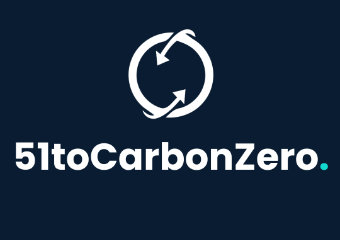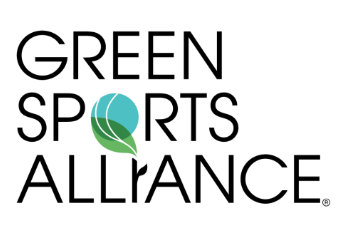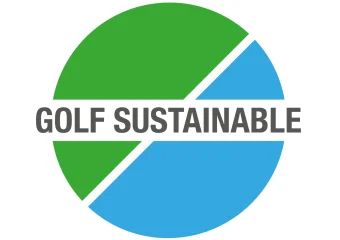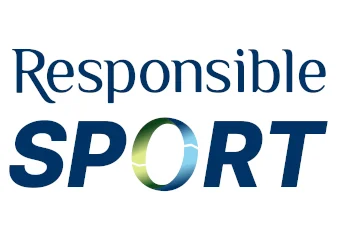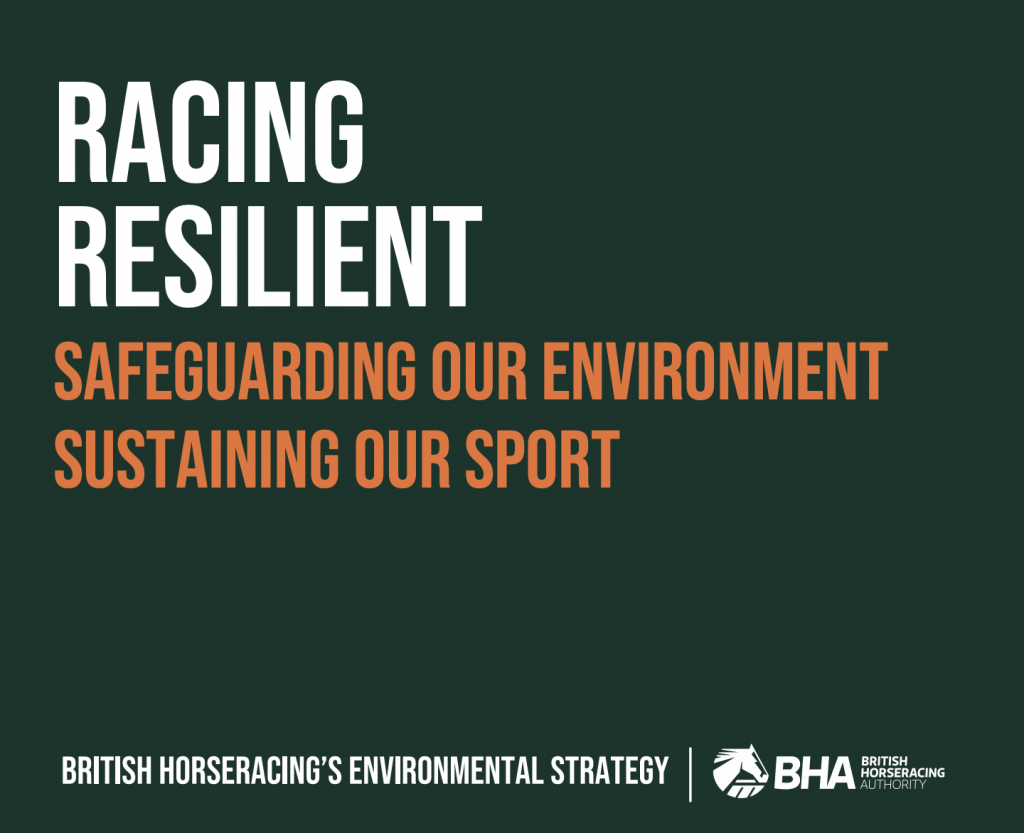To access our unique news archive of over 1,400 articles with insights on over 500+ sustainable sports organisations, join the GSS Network today.
Login here if you are a registered network subscriber.
News article
Arsenal vs. Tottenham: Why the perception of two UNFCCC signatories GHG Emissions appearing to vary by over 4 times creates a confusing picture for fans, brands and the media
In the increasingly environmentally conscious world of professional football, Premier League rivals Arsenal and Tottenham Hotspur have both made significant commitments to sustainability and carbon reduction. However, their approaches to greenhouse gas (GHG) emissions reporting and measurement methodologies reveal notable differences in detail and comprehensiveness.
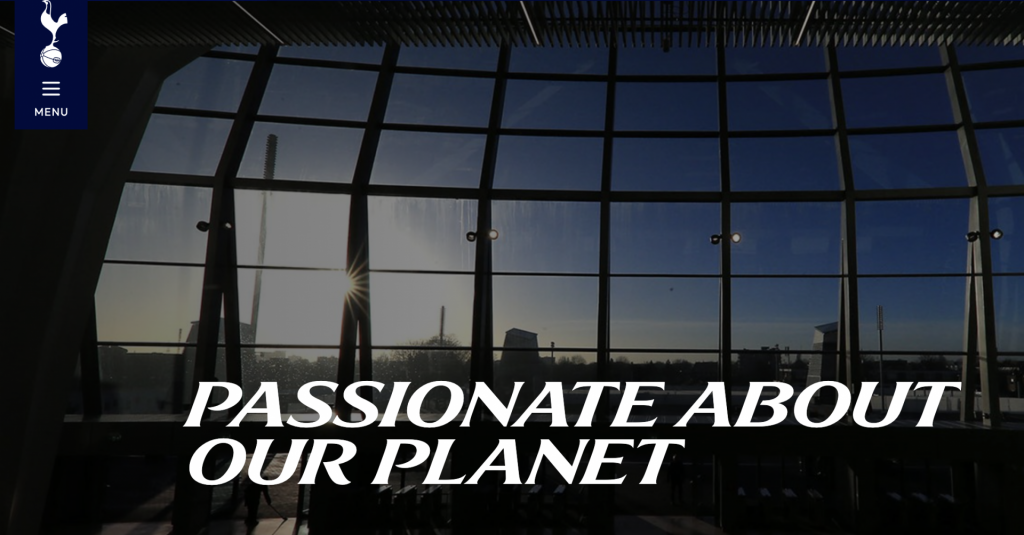
With their publicly available figures on their respective greenhouse gas emissions appearing to vary by over 4 times the perception for sport does not give a clear picture to fans, brands and the media. Two clubs that are almost identical in terms of stadium size and annual attendance should, in principle, have a similar sized footprint. Global Sustainable Sport analyses this apparent variation and asks why there are no clear guidelines for sport when it comes to GHG reporting as opposed to financial reporting. For a financial report it is accepted that the turnover of the two clubs can be compared but for their GHG emissions that appears not to be the case.
Sustainability Recognition
Arsenal and Tottenham Hotspur have both been recognised as leaders in their commitment to sustainability through various awards and initiatives.
Arsenal became the first football club globally to have its net-zero target of 2040 approved by the Science Based Targets initiative (SBTi). The club topped the Premier League sustainability ranking, achieving the highest scores in energy efficiency, clean energy, sustainable transport, and waste management. Additionally, its Diamond Club restaurant was the first sports venue to receive a Three-Star rating from the Sustainable Restaurant Association (SRA) for responsible food sourcing and waste reduction.
Tottenham Hotspur won the Schneider Electric Sustainability Impact Award for its commitment to energy efficiency and reliance on 100% renewable energy at its stadium. The club also obtained ISO 20121 certification, a standard for sustainable event management, reinforcing its goal of reaching net-zero by 2040. Furthermore, Tottenham received the Biodiversity Project of the Year award for its smart sound biodiversity monitoring system at its Training Centre, which enhances local ecosystems.
Both clubs have clearly demonstrated leadership in sustainable sport, setting benchmarks for environmental responsibility through innovative energy initiatives, waste reduction, and biodiversity protection efforts.
Stadium Capacities
Arsenal and Tottenham Hotspur have moved into relatively new stadiums in the last 20 years. Arsenal moved into its current stadium in 2006 and Tottenham Hotspur in 2019. Their capacities are roughly similar. Arsenal’s Emirates Stadium has a capacity of 60,704, while the Tottenham Hotspur Stadium holds 62,850 spectators.
During the 2023-24 Premier League season, Arsenal’s home matches attracted a total of 1,144,488 spectators, averaging 60,236 per game. Tottenham Hotspur’s home games drew a total attendance of 1,167,725, with an average of 61,459 per match.
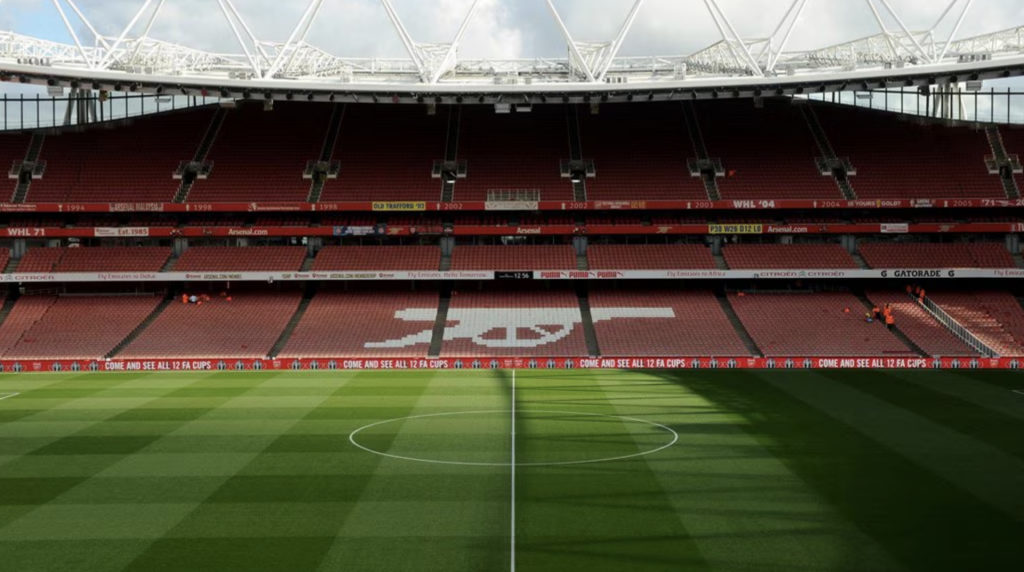
The Scale of Emissions: Arsenal vs. Tottenham
Given both clubs’ clear commitment to sustainability and their similar stadium sizes and attendance figures, why do their recently reported greenhouse gas (GHG) emissions vary so significantly?
Arsenal, in its recently reported annual accounts for 2023-24, has recorded its total GHG emissions for Scopes 1,2 and 3 at 22,088 tonnes of CO₂e. Meanwhile Tottenham, which has yet to publish its accounts for the last season, generated GHG emissions of 93,894 tonnes of CO₂e – over four times that of its rivals – in the club’s most recent report.
- Arsenal (2024): 22,088 tonnes of CO₂e
- Tottenham (2023): 93,894 tonnes of CO₂e
This fourfold difference raises questions about the approach to measurement and reporting methodologies between the two clubs.
Emissions Breakdown by Scope
According to their reports, both clubs follow the Greenhouse Gas Protocol’s framework of categorising emissions into the three standardly accepted scopes:
| Greenhouse Gas Emissions (tCO₂e) |
Arsenal’s Emissions (2024) |
Percentage of Total | Tottenham’s Emissions (2023): |
Percentage of Total |
|
Scope 1 (Direct emissions)
|
2315 |
10.5% | 2,503 |
2.7% |
|
Scope 2 (Purchased energy)
|
2,956 |
13.4% | 4,684 |
5.3% |
|
Scope 3 (Indirect/value chain)
|
16,746 | 76.1% | 86,444 |
92.0% |
|
Total Emissions
|
22,088 | 93,894 |
|
While both clubs report that Scope 3 emissions constitute the majority of their carbon footprint, Tottenham’s Scope 3 emissions account for a significantly larger proportion (92%) than Arsenal’s (76.1%) and are over four times larger. They are also reported in far greater detail and depth by Tottenham, indicating significant differences in either operational activities or reporting methodologies.
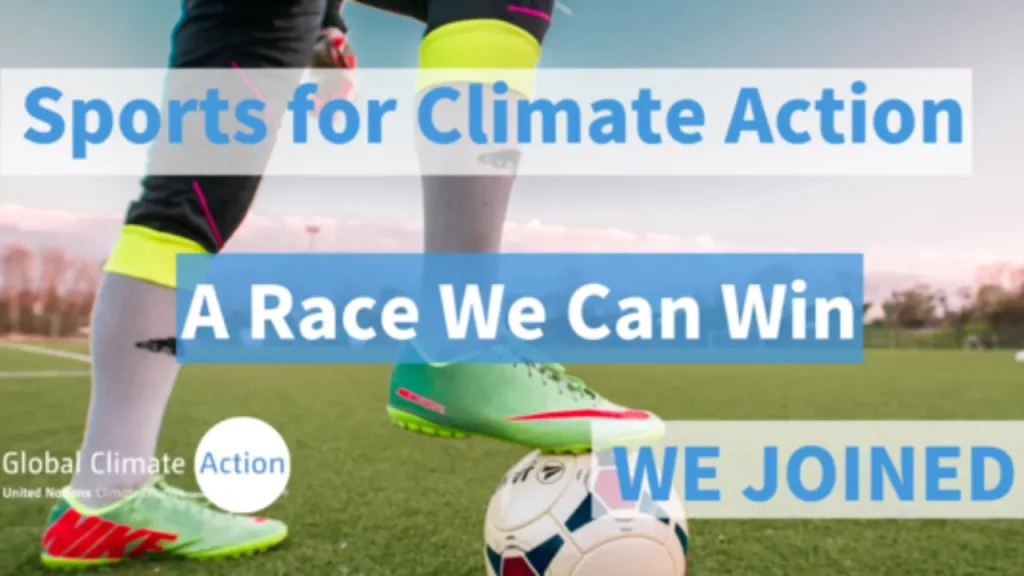
Commitments to UN Climate Initiatives
Both clubs are signatories to the UN Sports for Climate Action Framework (UNFCCC) and have committed to ambitious environmental goals:
Arsenal’s UN Commitments and Progress
- Net-zero by 2040, with Science Based Targets initiative (SBTi) validation in 2024.
- By 2030: 42% reduction in Scope 1 & 2 emissions; 52% reduction in Scope 3 emissions per million GBP revenue.
- By 2040: 90% reduction in Scope 1 & 2 emissions; 97% reduction in Scope 3 emissions per million GBP revenue.
- Utilises 100% green electricity since 2016.
- Water conservation efforts saving 4.5 million litres annually.
- Plastic reduction eliminating 150,000 single-use plastic bottles per year.
Tottenham’s UN Commitments and Progress
- Net-zero by 2040, with a goal of halving emissions by 2030.
- By 2030: 50% absolute reduction across all scopes (1, 2, and 3).
- By 2040: Net-zero emissions across all scopes.
- Top-ranked sustainable club in the Premier League in multiple years.
- Biodiversity protection initiatives, including bat houses, bug hotels, and wildflower meadows.
- Local sourcing and sustainable packaging efforts.
What is interesting here is that Tottenham has opted for an absolute reduction whereas Arsenal has stated a differential approach based on emissions per million GBP revenue. That means that Arsenal’s emissions could continue to rise but if its revenue rises in percentage terms more than its emissions, the club will seem to have achieved their objective without actually reducing absolute emissions.
The lack of a common methodology and approach here makes direct comparison challenging.
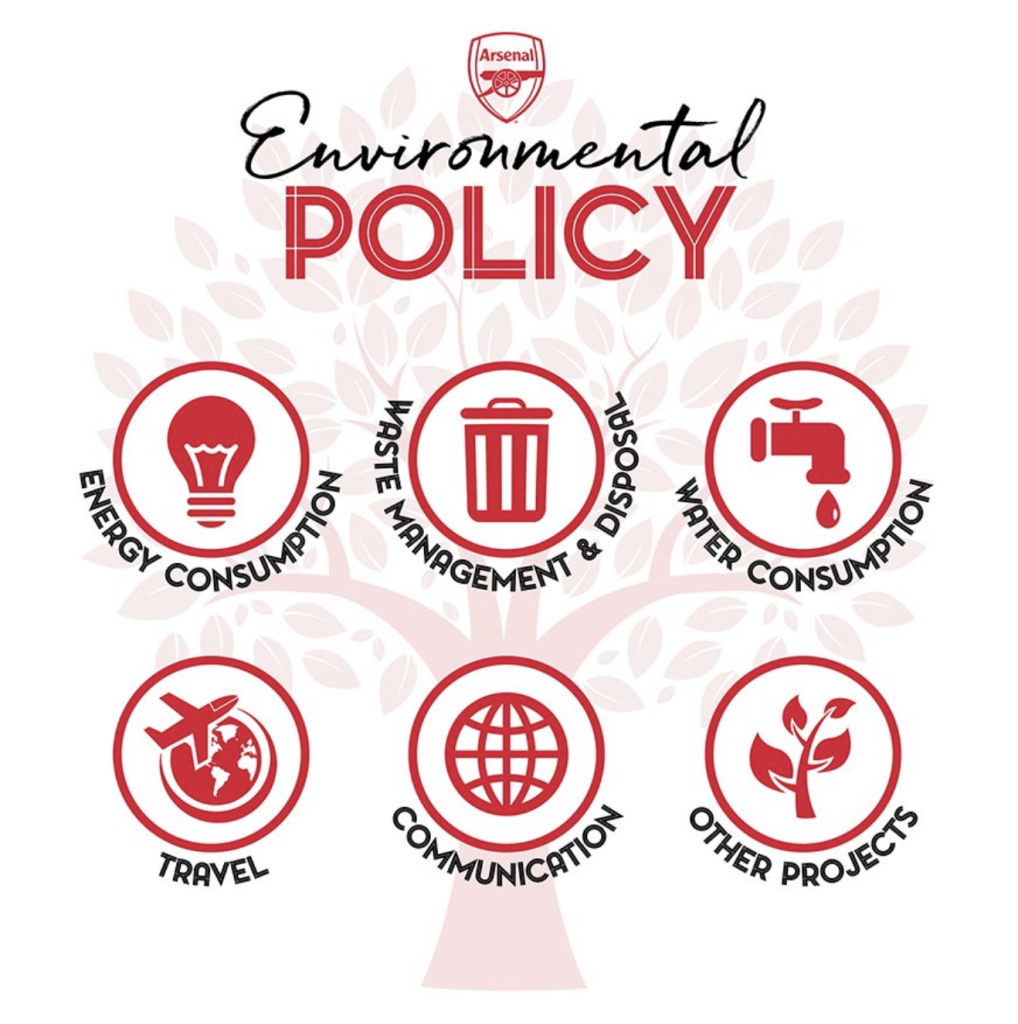
Year-on-Year Emission Changes
Given that both clubs have given significant commitments to reducing their GHG emissions by 2030 it is interesting that both have reported increases in their emissions for their last period.
|
Greenhouse Gas Emissions (tCO₂e) |
Arsenal’s Emissions (2023-24) | Percentage Increase/Decrease | Tottenham’s Emissions (2022-23): |
Percentage Increase/Decrease |
|
Scope 1 (Direct emissions)
|
2315 |
-7%
|
2203 |
5% |
|
Scope 2 (Purchased energy)
|
2,956 |
38% | 4,734 |
1% |
|
Scope 3 (Indirect/value chain)
|
16,817 |
4% | 91,853 |
6% |
|
Overall
|
6% |
6% |
Both clubs have experienced an overall increase of roughly 6% across all scopes. Arsenal has managed to decrease its Scope 1 emissions by 7% but has seen its Scope 2 emissions increase by 38%, whereas Tottenham has seen small increases across all scopes.
Scope 3 Comparison
As can be seen from the Scope 3 Comparison below Arsenal’s Scope 3 emissions, as per their financial report for 2023/24, is recorded as two items: Mobile Combustion and Other Emissions.
Arsenal’s Scope 3 emissions
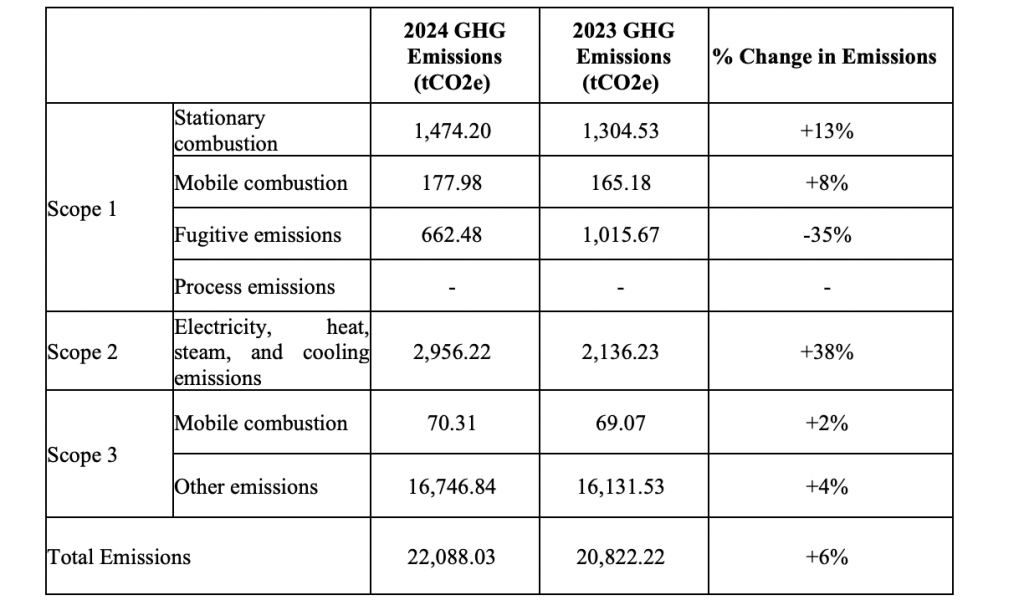
Tottenham’s Scope 3 emissions
Tottenham, on the other hand, report their emissions in greater detail with an ‘Additional’ entry for ‘Fan Travel’
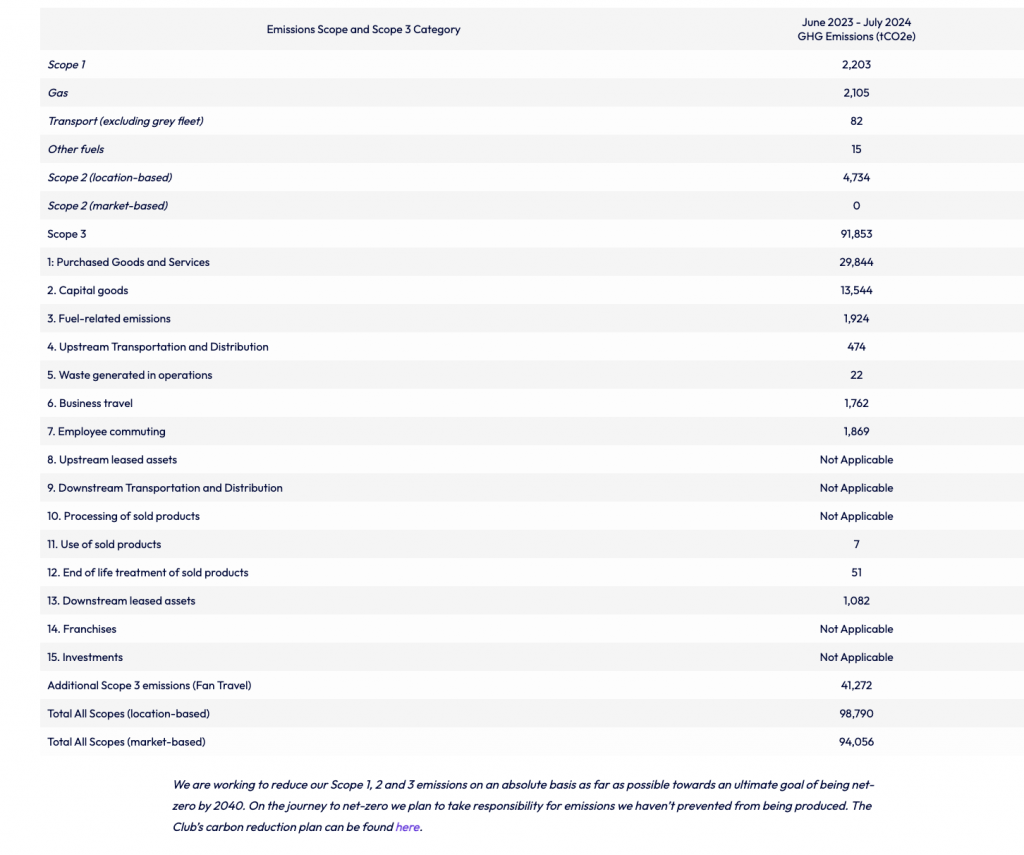
It is almost impossible from the information provided to compare these two scope 3 reports. According to Tottenham their Fan Travel element covers fan travel related to home fans and away fans attending matches at Tottenham’s stadium, but it does not cover Tottenham fans going to away matches.
It is not clear from Arsenal’s ‘Other Emissions’ if Fan travel is included in this at all but what is clear is that it doesn’t cover the full scope of fan travel emissions. GSS understands that the Arsenal figure was verified by the Science Based Targets initiative (SBTi) on the basis that this figures represents what the club is “responsible” or has control for.
Comparing Carbon Intensity
Given the huge variation in Scope 3 emissions, it is not possible to compare carbon intensity figures between the two clubs using all three scopes so the only comparative we can use is the carbon intensity figure for Scope 1 and 2 combined per £100,000 of revenue.
| Greenhouse Gas Emissions (tCO₂e) |
Arsenal’s Emissions (2022-23) |
Arsenal’s Emissions (2023-24) | Tottenham’s Emissions (2022-23): |
Tottenham’s Emissions (2022-23): |
|
Total Scope 1 & 2 |
4621.70 |
5270.88 |
6784.53 |
6937.00 |
|
Scope % Change |
|
+14% |
+2.24% |
|
|
Revenue |
£464.6 |
£616.6m |
£549.6 |
? |
|
Revenue % Change |
+£32% |
|
||
|
Carbon Intensity Ratio per £100,000 of revenue |
0.99 |
0.86 | 1.25 |
|
|
Carbon Intensity % Change |
|
-13% |
? |
For Arsenal their total Scope 1 and 2 figure is 5270.88 tCO₂e. For the 2023/24 season Arsenal’s revenue was £616.6 million which gives a Carbon Intensity figure of 0.86 per £100,000 of revenue. As you can see from the above in absolute terms Scope 1 & 2 emissions increased by 14% from 2022/23 but revenue grew by 32% resulting in the Carbon Intensity Ratio falling by 13%
Tottenham have not published their accounts for the 2023/24 season yet, so it is not possible to provide a comparison between the two seasons.

Reporting Frameworks and Methodologies
Arsenal’s Reporting Approach
- Streamlined Energy and Carbon Reporting (SECR): Arsenal explicitly follows this UK regulatory framework, providing detailed breakdowns of emissions sources.
- UNFCCC: Arsenal adhere to UNFCCC guidelines and provide an annual report to the UNFCCC.
- GHG Protocol Adherence: Arsenal clearly states its adherence to the GHG Protocol Corporate Accounting and Reporting Standard.
- Transparency on Estimation: Arsenal discloses that approximately 65% of its total emissions are based on estimation, primarily due to incomplete data from fan travel, employee commuting, supply chain, and e-commerce freight.
- Science-Based Targets Initiative (SBTi): Arsenal’s targets have been validated by the SBTi, providing third-party verification of their ambitions.
- Intensity Metrics: Arsenal reports carbon intensity metrics based on both revenue (3.61 tCO₂e per £100,000) and full-time equivalent employees (26.93 tCO₂e per FTE).
Tottenham’s Reporting Approach
- BSI ISO 20121 certification: The club was one of the first Premier League clubs to obtain an ISO 20121 certification, a standard for sustainable event management, reinforcing its goal of reaching net-zero by 2040.
- UNFCCC: Tottenham adhere to UNFCCC guidelines and provide an annual report to the UNFCCC
- GHG Protocol Adherence: Tottenham also clearly states its adherence to the GHG Protocol Corporate Accounting and Reporting Standard.
- Third-Party Verification: While Tottenham references UN climate initiatives, there is no explicit mention of SBTi validation for its targets.
- Intensity Metrics: The available documents do not detail carbon intensity metrics related to revenue or employees.
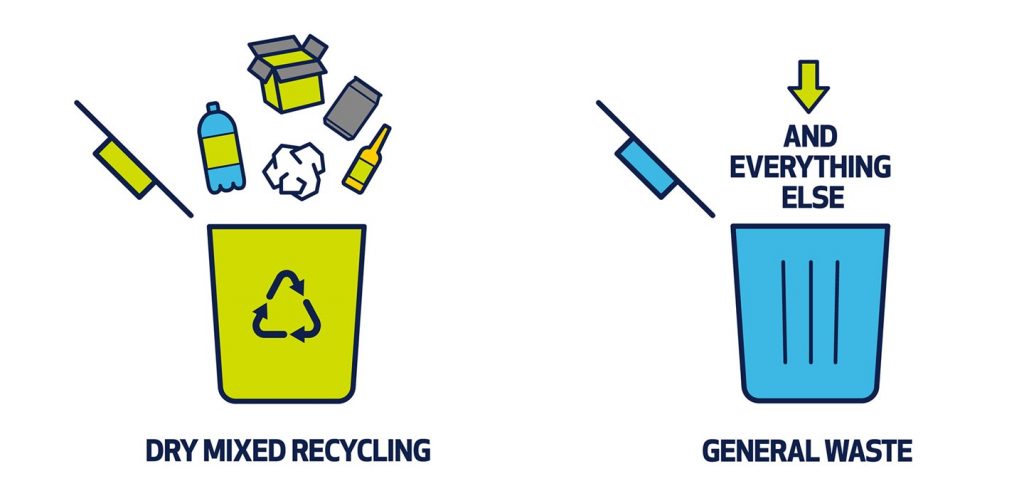
Sustainability Initiatives
It is clear that both clubs have implemented significant measures to reduce their environmental impact:
Arsenal’s Initiatives
- Renewable Energy: 100% green electricity since 2016.
- LED Lighting: Replacement of 8,000 lights with LED alternatives at Emirates Stadium.
- Water Conservation: A water reuse system saving 4.5 million litres annually.
- Vehicle Electrification: Replacement of diesel leased vehicles with electric alternatives.
- Arsenal Forest: Tree-planting initiative in Kenya covering 33 acres (equivalent to 20 football pitches).
- Training Ground Greening: More than 29,000 trees planted at the London Colney Training Centre.
Tottenham’s Initiatives
- Sustainable Packaging: Transition from plastic to Tetrapak for drinks and reduced food packaging.
- Local Sourcing: 50% of food deliveries originate within 50 miles of the stadium.
- Energy Efficiency: Upgraded to LED lighting at training facilities and installed a heat pump for pitch heating.
- Biodiversity: Bat houses, bug hotels, and wildflower meadows.
- Net-zero Match: Hosted the world’s first net-zero carbon elite-level football match in September 2021.
Reporting Differences Amongst Premier League Clubs
The substantial difference in total reported emissions, 22,088 tCO₂e for Arsenal vs. 93,894 tCO₂e for Tottenham. and in particular for Scope 3 emissions lies at the heart of the challenge to understand who is doing what with regard to their emissions, creating a confused picture for fans, brands and the media.
Arsenal and Tottenham are two clubs that have clearly shown real leadership in the sustainability space. In terms of Scope 3, Liverpool is the only other club showing a comparable figure to Tottenham of 74,818 tCO₂e, although this is not quoted in their recently filed financial report for 2023-24. Manchester City has a similar figure (29,287 tCO₂e)) to Arsenal’s emissions but publish figures on fan travel and equally rely heavily on estimations.
Recent signatories to the UNFCCC like Nottingham Forest, Brentford and Wolverhampton Wanderers have started to show signs of a more robust approach to their Scope 3 measurement and Brighton and Hove Albion are planning to publish a full Scope 1, 2 and 3 report later in 2025.
Outside of these clubs it would appear that very few clubs are looking at their full scope figures, and top-flight newcomer Ipswich Town has no publicly available figures for any scope emissions.
Given that Tottenham and Arsenal both have relatively modern stadiums and similar size capacities it would appear that the lack of a clear agreed approach to reporting amongst the Premier League clubs accounts for this huge discrepancy in published figures.
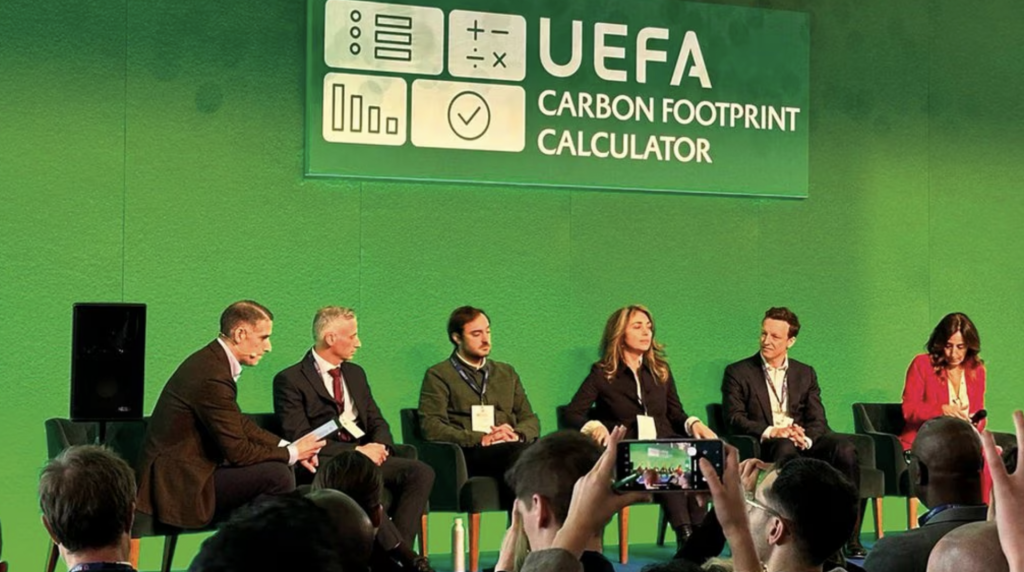
Industry Guidelines and Guidance
This is all the more surprising given the UNFCCC, UEFA and the Premier League’s guidance on GHG reporting. The UNFCCC provide a framework for all its signatories to report on. UEFA has developed its Carbon Footprint Calculator – and Arsenal was one of the clubs that participated in their trial programme to develop the tool.
The UEFA calculator aims to help football clubs consistently report on their GHG emissions. With over 150 clubs already using the calculator, one would hope to see more consistency in the reporting of Scope 3 emissions.
Greater alignment with standardised reporting frameworks would facilitate more direct comparisons between clubs and across seasons presenting a clear and unified approach to carbon reporting
Commenting on this Richard Davis, CEO of carbon management specialists 51toCarbonZero stated:
“It’s great to see top clubs like Arsenal and Tottenham becoming increasingly transparent about their carbon footprint and taking meaningful action. However, comparing carbon footprints across different organisations can be quite challenging.
The carbon accounting standard allows some flexibility in defining the boundaries of a company’s footprint and deciding which emission categories to include for Scope 3. In football, this can lead to inconsistencies. For example, whether to include or exclude fan travel or merchandising emissions. Even within the same category, measurement methods can vary. For instance, merchandising emissions could be calculated based on the number of items sold, the materials used, or the revenue generated.
These variations make it difficult to accurately compare footprints between clubs. That’s why we’re looking forward to continuing working with GSS to establish a shared emission framework as a platform to create industry benchmarks that support a more sustainable and fair growth path for the sports sector.”
Improved data collection from fan travel, supply chains, and other indirect sources would enhance reporting accuracy and at the same time create potential opportunities for commercial programmes that significantly help to reduce GHG emissions.
"It’s great to see top clubs like Arsenal and Tottenham becoming increasingly transparent about their carbon footprint and taking meaningful action. However, comparing carbon footprints across different organisations can be quite challenging."
Clear Need for Standardised Methodologies
Both Arsenal and Tottenham Hotspur have clearly demonstrated tremendous commitments to environmental sustainability, with comprehensive emissions reporting and ambitious reduction targets. However, their approaches reveal significant differences in approach and methodology.
The substantial difference in reported emissions highlights the need for a standardised reporting framework across football clubs and sport as a whole. As environmental concerns become increasingly important to fans, sponsors, regulators, and the media, both clubs have opportunities to build on their existing commitments and address gaps in their approaches to circular economy, fan engagement, and comprehensive data reporting.
While the North London rivalry continues on the pitch, both clubs are positioning themselves as leaders in sustainability within professional football. Their continued progress and transparent reporting will be essential in inspiring broader change throughout the global sports industry and beyond.
Sources:
Arsenal: https://www.arsenal.com/the-club/corporate-info/arsenal-holdings-financial-results
Tottenham: https://www.tottenhamhotspur.com/the-club/passionate-about-our-planet/
Research: Sally McKendry, GSS Research
Read moreGSS Research
Join the GSS Alliance Partners programme today
Stay ahead of the game with our FREE weekly newsletter, delivering the latest sport and sustainability news from around the globe straight to your inbox
Join the GSS Network programme today
Register for GSS Workshops today
Join the GSS Education programme today













